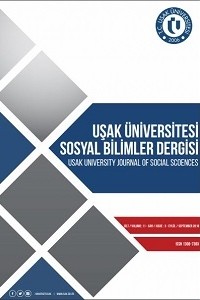Yurt Dışında Yaşayan İkinci Kuşak Türk Çocuklarının Türkçeyi Kullanım Durumları ve Dil-Kültür İlişkisi
Bu çalışmada, Amerika Birleşik Devletlerinde yaşamakta olan özellikle ikinci kuşak Türk çocuklarının ana dilleri olan Türkçeyi kullanımı, aileleri ile olan iletişimleri ve kültürel unsurlar, çocukların yaşamakta oldukları dil ve kültür çatışmaları, ayrıca ailelerin kendi ana dillerini ve kültürlerini sürdürmek için neler yaptıkları incelenmiştir. Bu amaç doğrultusunda, nitel araştırma yöntemlerinden olan durum (örnek olay) incelemesi tekniği kullanılmıştır. Bu araştırmanın sonucunda; 1) ailelerin ana dillerini koruma ve sürdürme çabalarına rağmen ikinci kuşak Türk çocuklar arasında İngilizcenin yaygın olarak kullanıldığı; 2) ikinci kuşak çocukların kültürel uyum sorunu çektiği, dil ve kültür çatışması yaşadıkları; 3) aile ile çocuklar arasında kültürel uyuşmazlıkların olduğu; 4) eğitim kurumlarının dil ve kültür aktarımında belirleyici bir faktör olduğu sonuçlarına ulaşılmıştır.
Anahtar Kelimeler:
Yurt dışında yaşayan ikinci kuşak Türk çocukları, ana dil, Türk kültürü, kültürel çatışma
Case of Using Turkish Language of Second-Generation Turkish Children Living Abroad and Relationship Between Language-Culture
In recent years, Turkish population in the United States as in Europe has increased substantially. Strong pressures from the American culture and language have commonly led to weakening and even the extinction of Turkish language and culture especially in the second generation of children with native language is Turkish. In this study, use of Turkish language of second-generation Turkish children living in the United States, communications with their families and cultural elements in those communications, their language and cultural conflicts, as well as their families do to maintain their native language and culture were examined. For this purpose, the case study method was used in qualitative research methods. Communications between a Turkish family and their 5 and 11 years old children were being observed in a certain period of time and the written notes were taken. Unstructured interviews were conducted with Turkish family and children and documents were also examined to support the findings. Results of the study indicate that: 1) Despite the efforts of families to maintain and protect the native language, English is widely used among second-generation Turkish children, 2) the second generation of children have the problem of acculturation and language and culture conflict, 3) the cultural inconsistency between family and children; 4) educational institutions are the determining factor in the transmission of language and culture.
Keywords:
Second-generation Turkish children living abroad, native language, Turkish culture, cultural conflict,
___
- Bruner, J. (1990). Acts of Meaning, Harvard University Press: Cambridge.
- Bruner, J. (1996). The Culture of Education, Harvard University Press: Cambridge.
- Damen, L. (1987). Culture Learning: The Fifth Dimension in the Language Classroom, Addison-Wesley: Reading.
- Fairclough, N. (1989). Language and Power, Longman: London.
- Fairclough, N. (1995). Critical Discourse Analysis, Longman: London.
- Henle, P. (1970). Language, Thought and Culture, Michigan University Press: Michigan.
- Holquist, M. (1990). Dialogism: Bakhtin and His World, Routledge: London.
- Howell, W., R. & Vetter, J., H. (1976). Language in Behaviour, Human Sciences Press: New York.
- Landar, H. 1965. Language and Culture, Oxford University Press: USA.
- Nuruan, M., Güneş, T., Şen, R., B., Güneş, S., Kalaycı, A., R. & Kaplan, M. (2005). Federal Almanya’da Yaşayan Türklerin Aile Yapısı ve Sorunları Araştırması, Aile ve Sosyal Araştırmalar Genel Müdürlüğü: Ankara. Ochs, E., & Schieffelin, B. (1984). Language Acquisition and Socialization. In R. Shweper & R. Levine (Eds.), Culture theory (pp. 277-320). Oxford University Press: Oxford.
- Peck, D. (1998). Teaching Culture: Beyond Language, New Haven Teachers Institute: Yale.
- Peters, A., & Boggs, S. (1986). Interactional Routines as Cultural Influences Upon Language Acquisition. B. Schieffelin and E. Ochs (Eds.), Language socialization across cultures (pp. 80-96). Cambridge University Press: Cambridge.
- Portes, A. & Schauffler, R. (1994). “Language and the Second Generation: Bilingualism Yesterday and Today”, International Migration Review, 28 (4), 640-661.
- Poyatos, F. (1985). Encoding-decoding Processes in Verbal and Nonverbal Interaction. In R. Brunt & W. Enninger (Eds.), Interdisciplinary perspectives at cross-cultural communication (pp. 191- 210). Rader: Achen.
- Salzmann, Z. (1998). Language, Culture and Society: An Introduction to Linguistic Anthropology, Westview Press: USA.
- Steele, R. (1989). Teaching Language and Culture: Old Problems and New Approaches. In J.E. Alatis (Ed.), Georgetown University roundtable on languages and linguistics (pp. 153-162). Georgetown University Press: Washington.
- Vygotsky, L.,S. (1962). Thought and Language. (E. Hanfmann & G. Vakar, Trans. & Eds.). MIT Press: Cambridge.
- Vygotsky, L., S. (1978). Mind and Society: The Development of Higher Psychological Process, M. Cole, V. John-Steiner, S. Scribner, & E. Souberman (Eds.), Harvard University Press: Cambridge.
- Wells, G. (Ed.). (1981). Learning Through Interaction: The Study of Language Development, Cambridge University Press: Cambridge.
- Wink, J., & Putney, L. (2002). A vision of Vygotsky. Allyn & Bacon: Boston.
- Yavuzer, H. (2009). “Amerika’daki Türkler ve Kurmuş Oldukları Türk Dernekleri”, Zeitschrift für die Welt der Türken/ Journal of World of Turks, 1(1), 171-198.
- Yıldırım, A. & Şimşek, H. (2011). Sosyal Bilimlerde Nitel Araştırma Yöntemleri, Seçkin Yayıncılık: Ankara.
- ISSN: 1308-738X
- Başlangıç: 2015
- Yayıncı: Uşak Üniversitesi
Sayıdaki Diğer Makaleler
Harita Beceri Düzeyleri ile Öğrenme Stilleri Arasındaki İlişkinin Belirlenmesi Üzerine Bir İnceleme
11. Sınıf Öğrencilerine Ait Öyküleyici Metinlerin Bağdaşıklık Ve Tutarlılık Açısından İncelenmesi
Türkçe Öğretmeni Adaylarının Okumaya ve Okuma Eğitimine İlişkin Özyeterlik Algıları
Mehmet KURUDAYIOĞLU, Gamze ÇELİK
Murat BAŞAR, Mustafa Yalçın Ayşe ÖZDEMİR
İçsel Güdülenme Envanteri Dilsel Eşdeğerlik, Güvenirlik ve Geçerlik Çalışması
Sınıf Öğretmeni Adaylarının İdeal Öğretmen ve Mesleki Yeterliklerle İlgili Değerlendirmeleri
Sosyal Bilgiler Öğretimi: Öğretmenim Bana Hikaye Anlatır mısın?
Sabri SİDEKLİ, Zafer Tangülü Selami YANGIN
Öğretmenlere ve Okul Yöneticilerine Verilen Hizmet İçi Eğitimlerin İrdelenmesi
